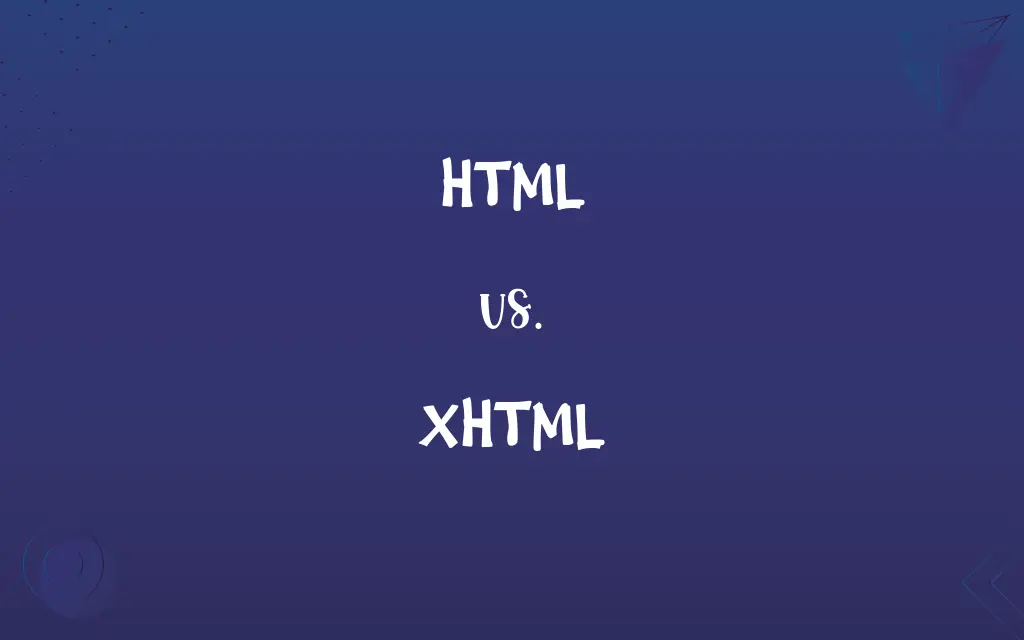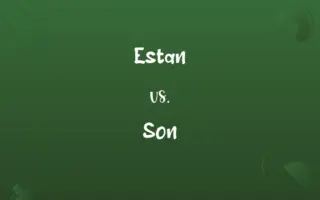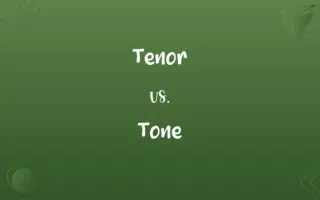HTML vs. XHTML: Know the Difference

By Shumaila Saeed || Published on February 28, 2024
HTML is a standard markup language for creating web pages; XHTML is a stricter variant of HTML, combining HTML with XML.

Key Differences
HTML, or HyperText Markup Language, is the standard language for creating and designing web pages and web applications. It uses tags to structure content on the web. XHTML, or Extensible HyperText Markup Language, is a reformulation of HTML as an XML application. It is stricter in syntax and was developed to ensure compatibility with XML parsers.
Shumaila Saeed
Feb 28, 2024
HTML allows for more lenient coding practices, meaning it often displays pages correctly even if the markup has minor errors. This flexibility makes it user-friendly for beginners. XHTML, on the other hand, is more rigid, requiring all elements to be properly closed and nested, and attributes to be in lower case and quoted, which leads to more consistent behavior across different browsers.
Shumaila Saeed
Feb 28, 2024
HTML uses a type of SGML (Standard Generalized Markup Language) and does not require that all tags be closed. This makes HTML more forgiving when it comes to syntax errors. In contrast, XHTML follows XML rules and therefore requires all elements to be properly closed, and does not allow shorthand notation for empty elements.
Shumaila Saeed
Feb 28, 2024
HTML documents can be displayed by web browsers even if they contain small syntax errors; the browsers can interpret the intent of the code. However, XHTML documents need to be well-formed to be displayed correctly, as they are treated as XML documents. This strictness can lead to better-structured and reliable code in XHTML.
Shumaila Saeed
Feb 28, 2024
HTML is typically used for building web pages that are primarily focused on presenting content. It's more suited for documents with a flexible structure. XHTML, being more strict, is often preferred for applications where document structure and data integrity are crucial, such as in web applications handling data exchange.
Shumaila Saeed
Feb 28, 2024
ADVERTISEMENT
Comparison Chart
Syntax Rules
More lenient, allows for unclosed tags.
Strict, requires properly closed tags.
Shumaila Saeed
Feb 28, 2024
Error Handling
Tolerant of errors, displays pages anyway.
Less tolerant, errors may prevent rendering.
Shumaila Saeed
Feb 28, 2024
Integration with XML
Not directly compatible with XML.
Compatible with XML, as it follows XML rules.
Shumaila Saeed
Feb 28, 2024
Case Sensitivity
Tags and attributes are case-insensitive.
Tags and attributes are case-sensitive.
Shumaila Saeed
Feb 28, 2024
Document Structure
Flexible, less rigid in structure.
Strict, encourages more structured documents.
Shumaila Saeed
Feb 28, 2024
ADVERTISEMENT
HTML and XHTML Definitions
HTML
The building block of web pages, defined by various elements and tags.
The HTML tag
is used for creating paragraphs.
Shumaila Saeed
Jan 19, 2024
XHTML
An application of XML that extends and reformulates HTML with stricter syntax.
XHTML requires all elements to be properly closed, enhancing code reliability.
Shumaila Saeed
Jan 19, 2024
HTML
A language for structuring and presenting content on the World Wide Web.
We used HTML to design our company's website.
Shumaila Saeed
Jan 19, 2024
XHTML
A markup language that combines the flexibility of HTML with the data structure of XML.
XHTML is ideal for web applications needing structured data handling.
Shumaila Saeed
Jan 19, 2024
HTML
A text-based approach to describe how content contained within a webpage is structured.
HTML helps in defining the structure and layout of web content.
Shumaila Saeed
Jan 19, 2024
ADVERTISEMENT
XHTML
A stricter version of HTML designed to enforce cleaner and more error-free coding.
Adopting XHTML leads to more consistent behavior across different web browsers.
Shumaila Saeed
Jan 19, 2024
HTML
A markup language that supports hyperlinks, allowing users to navigate between web pages.
HTML allows embedding links, making the internet interconnected.
Shumaila Saeed
Jan 19, 2024
XHTML
A reformulated HTML adhering to XML standards, ensuring compatibility with XML parsers.
XHTML documents need to be well-formed to display correctly in browsers.
Shumaila Saeed
Jan 19, 2024
HTML
The standard language for creating documents and applications on the internet.
HTML forms the backbone of every webpage we visit.
Shumaila Saeed
Jan 19, 2024
XHTML
A hybrid between HTML and XML, focusing on web document structure and data integrity.
XHTML's strict rules aid in creating well-structured web documents.
Shumaila Saeed
Jan 19, 2024
HTML
A markup language used to structure text and multimedia documents and to set up hypertext links between documents, used extensively on the World Wide Web.
Shumaila Saeed
Jan 17, 2024
HTML
A set of tags and rules (conforming to SGML) for using them in developing hypertext documents
Shumaila Saeed
Jan 17, 2024
Repeatedly Asked Queries
What is HTML?
HTML is the standard markup language for creating and designing web pages and web applications.
Shumaila Saeed
Feb 28, 2024
What is XHTML?
XHTML is a stricter version of HTML, combining HTML's features with XML's syntax rules.
Shumaila Saeed
Feb 28, 2024
What doctype declaration is used in HTML?
HTML uses a variety of doctype declarations depending on the version, like html> for HTML5.
Shumaila Saeed
Feb 28, 2024
Why might someone choose XHTML over HTML?
XHTML is chosen for its strict syntax, which can lead to more reliable and well-structured code.
Shumaila Saeed
Feb 28, 2024
Can HTML and XHTML be used together?
While they have distinct rules, HTML and XHTML can coexist in web development, especially when transitioning from one to the other.
Shumaila Saeed
Feb 28, 2024
How does HTML handle errors?
HTML is lenient with errors, often displaying pages correctly despite minor mistakes in the markup.
Shumaila Saeed
Feb 28, 2024
Is XHTML compatible with XML?
Yes, XHTML is an application of XML and is fully compatible with XML parsers.
Shumaila Saeed
Feb 28, 2024
What doctype declaration is used in XHTML?
XHTML uses XML-based doctype declarations, like html PUBLIC "-//W3C//DTD XHTML 1.0 Strict//EN">.
Shumaila Saeed
Feb 28, 2024
Can XHTML pages contain errors?
XHTML requires well-formed code, so any significant errors can prevent the page from rendering correctly.
Shumaila Saeed
Feb 28, 2024
Must XHTML tags always be closed?
Yes, XHTML requires all tags to be properly closed.
Shumaila Saeed
Feb 28, 2024
Are XHTML tags case-sensitive?
Yes, XHTML tags and attributes are case-sensitive, following XML rules.
Shumaila Saeed
Feb 28, 2024
Is HTML tolerant to unclosed tags?
Yes, HTML can often handle unclosed tags without breaking the page.
Shumaila Saeed
Feb 28, 2024
How do scripting languages interact with HTML?
Scripting languages like JavaScript can interact seamlessly with HTML elements.
Shumaila Saeed
Feb 28, 2024
What's the future of HTML and XHTML?
HTML continues to evolve with web standards, while XHTML has seen less development in favor of HTML5.
Shumaila Saeed
Feb 28, 2024
What is the main use of HTML?
HTML is primarily used for creating and structuring content on the web.
Shumaila Saeed
Feb 28, 2024
Can HTML and XHTML be validated?
Yes, both can be validated using various tools to check for adherence to their respective standards.
Shumaila Saeed
Feb 28, 2024
How do scripting languages interact with XHTML?
XHTML requires scripting languages to be more structured and adhere to XML rules.
Shumaila Saeed
Feb 28, 2024
How does HTML handle inline and block elements?
HTML allows a mix of inline and block elements, with flexible rendering by browsers.
Shumaila Saeed
Feb 28, 2024
Is XHTML more rigid in handling inline and block elements?
Yes, XHTML is more strict in how inline and block elements should be structured.
Shumaila Saeed
Feb 28, 2024
Share this page
Link for your blog / website
HTML
Link to share via messenger
About Author
Written by
Shumaila SaeedShumaila Saeed, an expert content creator with 6 years of experience, specializes in distilling complex topics into easily digestible comparisons, shining a light on the nuances that both inform and educate readers with clarity and accuracy.






































































